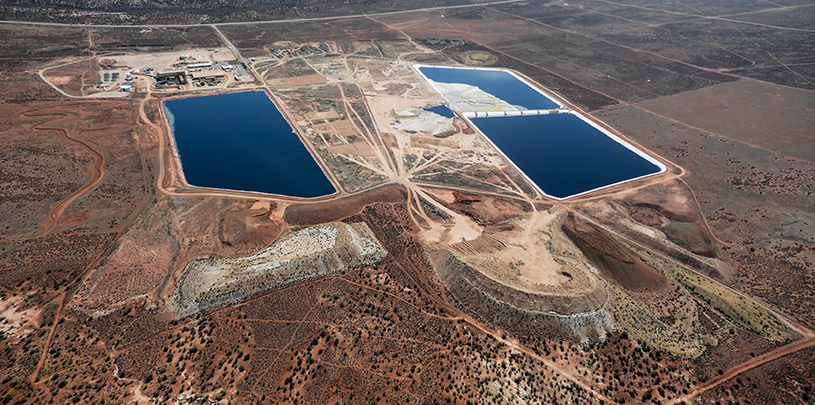
 by Anne Mariah Tapp, Energy Director
by Anne Mariah Tapp, Energy Director
Energy Fuels, the owner of the White Mesa uranium mill, dismisses claims made by “Half Life,” a Grand Canyon Trust film that argues that the mill puts groundwater at risk. We disagree with the company’s response.
“It’s straight out of the activist trade book,” an Energy Fuels spokesman told The Cortez Journal. “I’d say it is mostly bunk.”
To describe the concerns that Ute Mountain Ute Tribal Councilman Malcolm Lehi expressed for his community as “straight out of the activist trade book” is deeply disrespectful to the Ute Mountain Ute tribal nation and its members. The Trust respects and supports the sovereignty of the Ute Mountain Ute Tribe and created the “Half Life” film in part to communicate the tribe’s legitimate concerns through a medium more accessible to the general public. To dismiss those concerns as something out of the “activist trade book” shows a deep ignorance about the capacity of the tribal environmental department and entirely disregards the importance of a government leader expressing concerns about health impacts to the community he was elected to represent.
The company said there is “zero evidence” that tailing ponds are leaking into the groundwater. The company has more than 70 monitoring wells on and off the mill property.
In 2008, a nitrate/nitrite/chloride plume was detected at the mill site. In 2011, Energy Fuels and the state of Utah entered into a corrective action plan to address the nitrate plume. There is also a chloroform plume in the same general location as the nitrate/nitrite/chloride plume. Back in 1999, the Utah Division of Radiation Control urged the company to monitor groundwater for nitrate and nitrite, calling them “'smoking gun' leakage parameters.” There are also trends of groundwater with increasing acidity and elevated uranium in the same directions as the contamination plumes.
“We take protection of groundwater very seriously, and we have not received any violations relating to the tailing ponds or groundwater,” the spokesman said. “It is extremely monitored, and if a problem was found, we would address it.”
On the White Mesa Mill site, there is a deep supply well—WW-2—that pierces through the perched aquifer to the deeper Navajo Aquifer. The deeper Navajo Aquifer is the drinking water supply for most of southeastern Utah and northeastern Arizona, including the towns of Bluff, White Mesa, Kayenta, and Tuba City. WW-2 creates a vector for contamination to travel between the shallow perched aquifer and the deeper Navajo Aquifer. The White Mesa Mill did not undertake a well-casing analysis of WW-2—an analysis meant to guard against contamination of the deeper Navajo Aquifer—though the mill's groundwater discharge permit required one. And instead of finding a permit violation, the state used its enforcement discretion to relieve the mill of the obligation to conduct the well-casing analysis.
The mill has a long history of violations and civil penalties documented by the Utah Department of Environmental Quality.
On whether single-lined waste storage sites would be updated to double liners, a mill spokesman said there were no plans to do so because “there is not a problem.”
In 2011, the Ute Mountain Ute Tribe commissioned an independent mining consulting firm, RRD International, to study the state of the 30 mm PVC liners that are the only barriers between the contents of Cells 1, 2, and 3 and the groundwater. RRD International’s conclusions included the following points:
The company also said the film overstated its acceptance of alternative feed sources of uranium waste: "It is very low-level uranium, and we are authorized to accept it. It is a type of recycling that does not involve mining. If we did not take it to recover the uranium, it would go to a hazardous waste dump."
“Half Life” points out that the mill receives mixed waste from across North America. The mill currently stockpiles various alternate feed materials on-site, and it has received a license amendment allowing it to accept alternate feed from the Midnite Mine Superfund Site on the Spokane Reservation in Washington state. It has also asked the state for permission to accept waste from the Sequoyah Fuels project in Gore, Oklahoma. A facility that accepts and processes waste from Superfund sites should be held to the highest standards of environmental compliance. Anything less sets that site up to be designated as a Superfund site itself in the future. And if the White Mesa Mill is indeed out of compliance with the most protective environmental laws and regulations, then waste from other toxic sites should be going to highly regulated hazardous waste sites rather than the mill.
The company emphasized the critical role of the White Mesa Mill as a domestic nuclear energy supplier: “It is the only conventional operating mill in the U.S.. We process it at White Mesa instead of importing it from abroad.”
The White Mesa Mill is owned and operated by a subsidiary of Energy Fuels Inc., a Canadian company. Energy Fuels Inc. has long-term supply contracts for the yellowcake produced at the White Mesa Mill with international corporations. One of the largest customers of the yellowcake produced at the Mill is KEPCO, Korean Electric Power Company, the largest electric utility in South Korea. KEPCO is also the largest single shareholder of Energy Fuels Inc.
*This blog entry was updated on 10/5/2016.
Groundwater pumping at a uranium mine near the Grand Canyon will affect the canyon's springs, scientists says.
Read MoreA rally in Salt Lake City followed by a spiritual walk in White Mesa demonstrate the Ute community's determination to see uranium mill close.
Read MoreArizona Governor Katie Hobbs is the latest elected official to call for an environmental review of Pinyon Plain uranium mine.
Read More